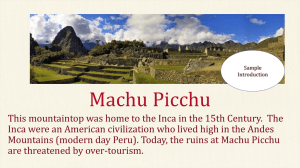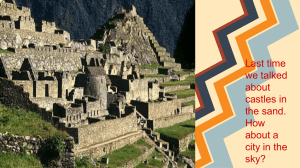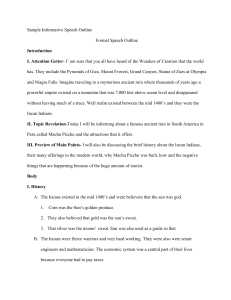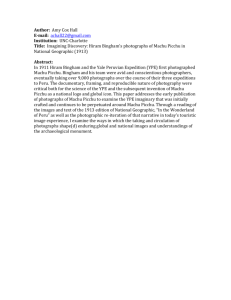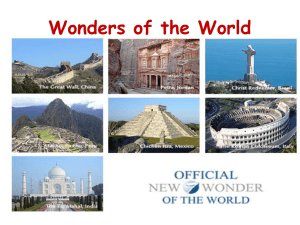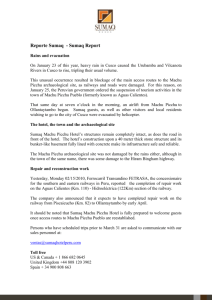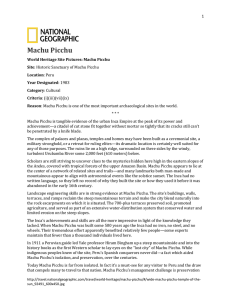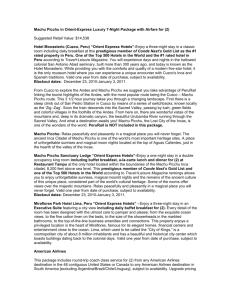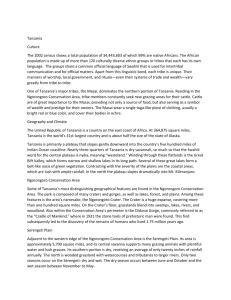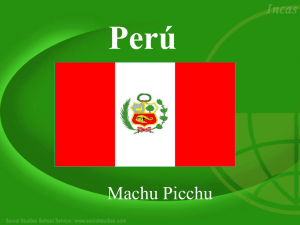Machu Picchu in Peru is famous as the Lost City of the Incas
advertisement
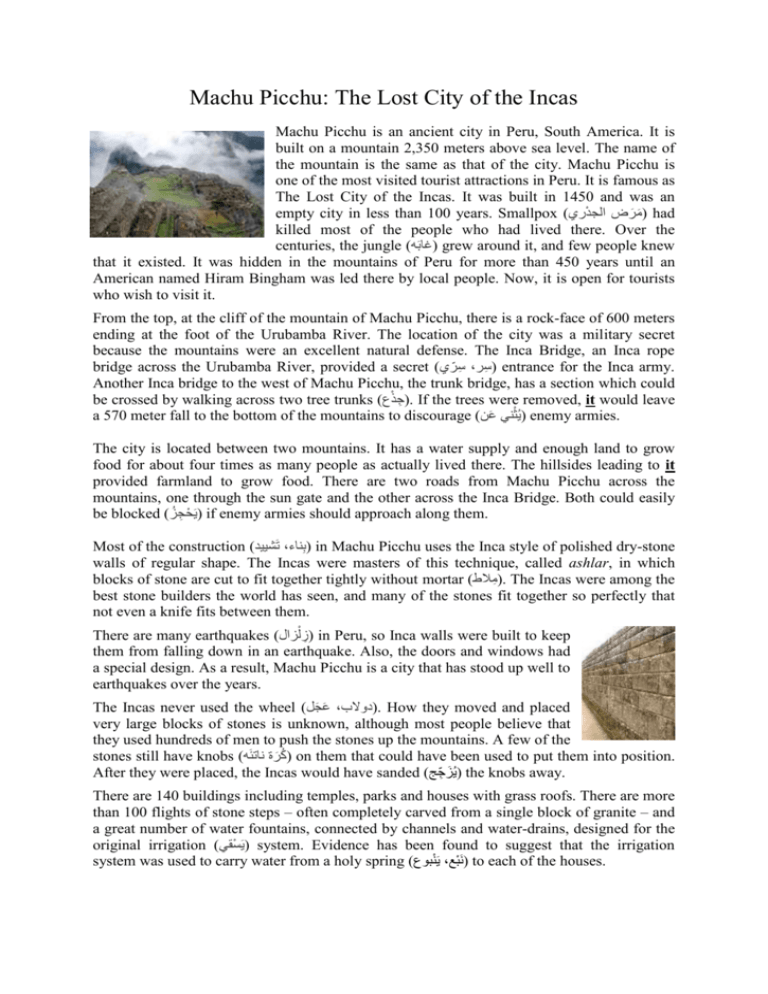
Machu Picchu: The Lost City of the Incas Machu Picchu is an ancient city in Peru, South America. It is built on a mountain 2,350 meters above sea level. The name of the mountain is the same as that of the city. Machu Picchu is one of the most visited tourist attractions in Peru. It is famous as The Lost City of the Incas. It was built in 1450 and was an empty city in less than 100 years. Smallpox ( ) َم َرض الجدْريhad killed most of the people who had lived there. Over the centuries, the jungle ( )غابَهgrew around it, and few people knew that it existed. It was hidden in the mountains of Peru for more than 450 years until an American named Hiram Bingham was led there by local people. Now, it is open for tourists who wish to visit it. From the top, at the cliff of the mountain of Machu Picchu, there is a rock-face of 600 meters ending at the foot of the Urubamba River. The location of the city was a military secret because the mountains were an excellent natural defense. The Inca Bridge, an Inca rope bridge across the Urubamba River, provided a secret ( ِس ّري، ) ِسرentrance for the Inca army. Another Inca bridge to the west of Machu Picchu, the trunk bridge, has a section which could be crossed by walking across two tree trunks ()جذْع. ِ If the trees were removed, it would leave a 570 meter fall to the bottom of the mountains to discourage ( )يُثْني َعنenemy armies. The city is located between two mountains. It has a water supply and enough land to grow food for about four times as many people as actually lived there. The hillsides leading to it provided farmland to grow food. There are two roads from Machu Picchu across the mountains, one through the sun gate and the other across the Inca Bridge. Both could easily be blocked ( ) َيحْ ِج ُزif enemy armies should approach along them. Most of the construction ( تَشييد، ) ِبناءin Machu Picchu uses the Inca style of polished dry-stone walls of regular shape. The Incas were masters of this technique, called ashlar, in which blocks of stone are cut to fit together tightly without mortar ()مالط. ِ The Incas were among the best stone builders the world has seen, and many of the stones fit together so perfectly that not even a knife fits between them. There are many earthquakes ()ز ْلزال ِ in Peru, so Inca walls were built to keep them from falling down in an earthquake. Also, the doors and windows had a special design. As a result, Machu Picchu is a city that has stood up well to earthquakes over the years. The Incas never used the wheel ( َع َجل،)دوالب. How they moved and placed very large blocks of stones is unknown, although most people believe that they used hundreds of men to push the stones up the mountains. A few of the stones still have knobs ( ) ُك َرة ناتئ َهon them that could have been used to put them into position. After they were placed, the Incas would have sanded ( )جِّ ج ُ زَيthe knobs away. There are 140 buildings including temples, parks and houses with grass roofs. There are more than 100 flights of stone steps – often completely carved from a single block of granite – and a great number of water fountains, connected by channels and water-drains, designed for the original irrigation ( ) َيسْقيsystem. Evidence has been found to suggest that the irrigation system was used to carry water from a holy spring ( )عجبْنَي جج ْعبَنto each of the houses. The urban ( خاص بال َمدينَه، ) َمدَنيsector of Machu Picchu was divided into three sections: the Sacred District, the Popular District, to the south, and the District of the Priests and the Nobility. Located in the first section are the most important archaeological treasures: the Intihuatana, the Temple of the Sun and the Room of the Three Windows. These were ّ ِ َ )يُدto Inti, their sun god. The dedicated (ص ُ ص ّ ِ يُ َخ،شن Popular District, or Residential District, is the place where the lower-class people lived. In the royalty area, there was a sector for the emperor and princes: a group of houses located in rows over a slope. The residence of the amautas (wise persons) was characterized by its reddish walls, and the zone of the ñustas (princesses) had trapezoidshaped rooms. The Monumental Mausoleum is a carved statue with carved drawings. As part of their road system, the Incas built a road to Machu Picchu. Today, tens of thousands of tourists walk the Inca Trail to Machu Picchu on a two- to four-day journey from the Urubamba valley up through the Andes Mountains.

